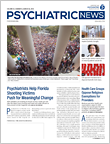Suicide is the 10th-leading cause of death overall in the United States and the second leading cause of death for teenagers and young adults aged 15 to 24. In 2016, almost 45,000 people died by suicide—51 percent by firearms, the most common means, according to the Centers for Disease Control and Prevention. Psychiatric and substance use disorders are the strongest individual risk factors for suicide. As much as 90 percent of individuals who die by suicide have a diagnosable psychiatric disorder at the time of death, most commonly depression or substance abuse.
Only two interventions have been empirically demonstrated to be effective in decreasing suicide mortality: mental health treatment and restriction of lethal means. Suicide risk assessment (SRA) is the gateway to effective treatment. These assessments decrease the risk of suicide by identifying modifiable or treatable acute, high-risk suicide factors and available protective factors that guide patient treatment.
Psychiatrists are taught that a systematic SRA requires exploration of suicidal ideation, whether a plan has been formulated, and if so, whether the patient has the means to carry out the plan. We then work to restrict a patient’s access to lethal means. For example, if a patient has considered suicide by overdose, we may agree to limit the amount of medication prescribed at any one time. Similarly, if a patient identifies firearms as a method of choice, a firearm safety plan might include confirming that guns and ammunition have been separated, removed from the home, and safely secured in a location unknown to the patient.
Regardless of whether a patient identifies firearms as a considered means of suicide, psychiatrists should always ask patients about their access to firearms because of the frequency of firearm suicide. The likelihood that a specific method of suicide will lead to death is related to its accessibility. The presence of firearms in the home is associated with a significantly increased risk of suicide. The association between higher rates of overall suicide and firearm suicide and higher rates of gun ownership is independent of psychopathology.
If a suicidal patient has access to firearms, even if that patient is not the owner and regardless of the presence or absence of other risk factors, steps should be taken to separate the individual from the firearms. Psychiatrists can work with high-risk patients to remove firearms from a patient’s immediate environment, even if the removal is temporary. Outcomes data showing that reduced access to firearms is linked to lowered suicide rates are robust.
The following steps should be considered when patients have access to firearms:
•
Ask about access to guns at home or elsewhere. Patients who have a gun at home often have more than one gun.
•
Consider invoking emergency exception to confidentiality if a patient at high risk for suicide withholds consent to contact significant others.
•
Involve significant others and the patient in designing a firearm safety plan, including discussions of clinical criteria for return of firearms.
•
Educate patients that the risks of a fatal suicide increase when firearms are accessible and drugs or alcohol are used and that the safest option is removal of guns from the home.
•
Designate a responsible individual to follow through with the gun safety plan.
•
Confirm via callback from the designated person that the gun safety plan has been implemented.
•
Document that the gun removal plan was implemented and that a callback was received from the designated individual.
•
Repeat suicide risk assessments, particularly before a treatment decision that may restore access to firearms.
Despite the common belief that individuals intent on dying by suicide who lack access to their preferred means will find another means to end their lives, most studies have demonstrated that restriction of one method does not inevitably lead to substitution of another method. In addition, when method substitution occurs, particularly if the preferred method is firearms, chances of surviving the suicide attempt increase due to the fact that other methods are less lethal. ■
References
Gold LH, Joshi KG: Suicide Risk Assessment. Edited by Gold LH, Frierson RL: The Textbook of Forensic Psychiatry, 3rd edition. Washington DC, American Psychiatric Publishing, Inc., 2018, pp. 403-420.
Ilgen, M. A., K. Zivin, R. J. McCammon, and M. Valenstein. 2008. "Mental Illness, Previous Suicidality, and Access to Guns in the United States." Psychiatric Services 59 (2): 198-200.
Mann JJ, Michel CA: Prevention of firearm suicide in the United States: what works and what is possible. Am J Psychiatry 173:969-979, 2016
Miller M, Barber C, Azrael D: Firearms and suicide in the United States. In Gold LH, Simon RI (eds): Gun Violence and Mental Illness. Washington DC: American Psychiatric Publishing Inc., 2016, pp. 31-48
Simon RI, Gold LH: Decreasing suicide mortality, in Gun Violence and Mental Illness. Edited by Gold LH, Simon RI. Washington DC, American Psychiatric Publishing, 2016, pp 249-289.
Yip, P. S., E. Caine, S. Yousef, S. S. Chang, K. C. C. Wu, and Y. Y. Chen. 2012. "Means Restriction for Suicide Prevention." Lancet 379: 2393-2399.

